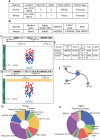AgeAnnoMO: a knowledgebase of multi-omics annotation for animal aging
- PMID: 37850649
- PMCID: PMC10767957
- DOI: 10.1093/nar/gkad884
AgeAnnoMO: a knowledgebase of multi-omics annotation for animal aging
Abstract
Aging entails gradual functional decline influenced by interconnected factors. Multiple hallmarks proposed as common and conserved underlying denominators of aging on the molecular, cellular and systemic levels across multiple species. Thus, understanding the function of aging hallmarks and their relationships across species can facilitate the translation of anti-aging drug development from model organisms to humans. Here, we built AgeAnnoMO (https://relab.xidian.edu.cn/AgeAnnoMO/#/), a knowledgebase of multi-omics annotation for animal aging. AgeAnnoMO encompasses an extensive collection of 136 datasets from eight modalities, encompassing 8596 samples from 50 representative species, making it a comprehensive resource for aging and longevity research. AgeAnnoMO characterizes multiple aging regulators across species via multi-omics data, comprehensively annotating aging-related genes, proteins, metabolites, mitochondrial genes, microbiotas and age-specific TCR and BCR sequences tied to aging hallmarks for these species and tissues. AgeAnnoMO not only facilitates a deeper and more generalizable understanding of aging mechanisms, but also provides potential insights of the specificity across tissues and species in aging process, which is important to develop the effective anti-aging interventions for diverse populations. We anticipate that AgeAnnoMO will provide a valuable resource for comprehending and integrating the conserved driving hallmarks in aging biology and identifying the targetable biomarkers for aging research.
© The Author(s) 2023. Published by Oxford University Press on behalf of Nucleic Acids Research.
Figures





References
-
- López-Otín C., Blasco M.A., Partridge L., Serrano M., Kroemer G.. Hallmarks of aging: an expanding universe. Cell. 2023; 186:243–278. - PubMed
-
- Cohen A.A. Aging across the tree of life: the importance of a comparative perspective for the use of animal models in aging. Biochim. Biophys. Acta Mol. Basis Dis. 2018; 1864:2680–2689. - PubMed
-
- Takahara T., Maeda T.. Evolutionarily conserved regulation of TOR signalling. J. Biochem. 2013; 154:1–10. - PubMed
MeSH terms
Substances
Grants and funding
LinkOut - more resources
Full Text Sources
Medical

